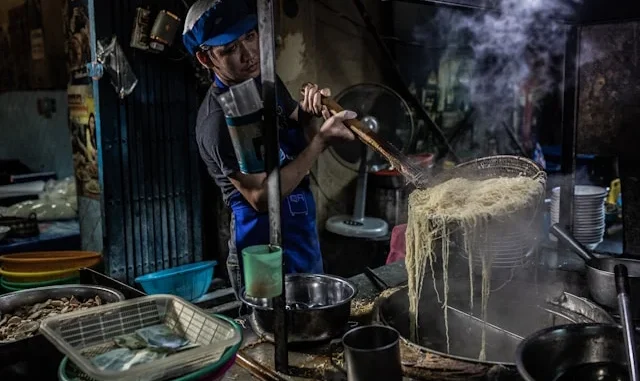
Thailand’s cuisine is a mesmerizing blend of vibrant flavors, aromatic spices, and unique regional specialties. In this ultimate guide, we delve deep into the must-try dishes and explore the culinary diversity of Thai food across different regions. Whether you’re a seasoned enthusiast or a curious newcomer, this guide will serve as your comprehensive map to the tantalizing world of Thai cuisine.
The Rich Tapestry of Thai Cuisine
Northern Thai Food: Lanna Delights
The cuisine of Northern Thailand, influenced by the Lanna Kingdom, is characterized by its mild and aromatic dishes. The cooler climate of this region means that food is often heartier and richer.
1. Khao Soi A quintessential Northern Thai dish, Khao Soi is a coconut curry noodle soup, garnished with crispy noodles, pickled mustard greens, shallots, and lime. Its creamy, spicy broth is a perfect comfort food.
2. Sai Oua (Northern Thai Sausage) This flavorful sausage is made from minced pork, herbs, and spices like lemongrass, kaffir lime leaves, and galangal. Grilled to perfection, Sai Oua is a staple in Northern Thai cuisine.
3. Nam Prik Ong A spicy dip made from minced pork, tomatoes, and chilies, Nam Prik Ong is typically served with fresh vegetables and sticky rice. It’s a must-try for those who love a bit of heat in their food.
Northeastern Thai Food: Isan Flavors
Isan cuisine, from the Northeastern region, is known for its bold and fiery flavors, often featuring fermented ingredients and grilled meats.
1. Som Tum (Papaya Salad) A globally recognized dish, Som Tum combines shredded green papaya with tomatoes, green beans, peanuts, and a dressing made from fish sauce, lime juice, and chilies. It’s a refreshing and spicy salad that tantalizes the taste buds.
2. Larb This spicy meat salad, usually made with minced pork or chicken, is mixed with toasted rice powder, lime juice, fish sauce, and fresh herbs. Larb is a staple in Isan cuisine and offers a delightful blend of textures and flavors.
3. Gai Yang (Grilled Chicken) Marinated with a mix of coriander, garlic, and fish sauce, then grilled to juicy perfection, Gai Yang is a popular street food that pairs wonderfully with sticky rice and Som Tum.
Central Thai Food: The Heart of Thai Cuisine
Central Thailand’s cuisine is perhaps the most well-known internationally, featuring a balance of sweet, salty, sour, and spicy flavors.
1. Pad Thai A beloved dish worldwide, Pad Thai is a stir-fried noodle dish made with shrimp or chicken, eggs, tofu, bean sprouts, and peanuts, all brought together by a tangy tamarind sauce.
2. Tom Yum Goong (Spicy Shrimp Soup) This hot and sour soup is infused with lemongrass, kaffir lime leaves, galangal, and chilies, creating a fragrant and spicy broth that’s complemented by succulent shrimp.
3. Massaman Curry Known for its rich and creamy texture, Massaman Curry is made with beef or chicken, potatoes, peanuts, and a blend of warm spices such as cinnamon and cardamom. It’s a dish that reflects the influence of Persian cuisine on Thai food.
Southern Thai Food: Coastal Influences
Southern Thailand’s cuisine is heavily influenced by its coastal geography, resulting in dishes that feature fresh seafood and bold spices.
1. Gaeng Som (Sour Curry) This tangy and spicy fish curry is a hallmark of Southern Thai cuisine. Made with tamarind, turmeric, and a variety of fresh fish, Gaeng Som offers a unique and robust flavor profile.
2. Kua Kling A dry curry typically made with minced pork or beef, Kua Kling is intensely spicy and aromatic, thanks to the generous use of turmeric, chilies, and other spices.
3. Hoi Tod (Oyster Omelette) A popular street food, Hoi Tod combines fresh oysters with a crispy, savory omelette, often served with a tangy chili sauce. It’s a must-try for seafood lovers visiting the South.
Street Food: The Soul of Thai Cuisine
Mango Sticky Rice

No exploration of Thai food is complete without trying Mango Sticky Rice. This delectable dessert pairs sweet, ripe mangoes with glutinous rice cooked in coconut milk, creating a harmonious blend of flavors and textures.
Thai Iced Tea
A refreshing drink that’s perfect for cooling down in Thailand’s tropical heat, Thai Iced Tea is made from strong-brewed tea, sweetened with sugar and condensed milk, and served over ice.
Satay
Grilled skewers of marinated meat, usually served with a rich peanut sauce, Satay is a popular snack that’s easy to find at street stalls throughout Thailand.
Tips for Enjoying Thai Food
- Embrace the Spice: Thai food can be quite spicy, but the heat is an integral part of the experience. Start slow and gradually build your tolerance.
- Use Your Hands: Many Thai dishes, especially those involving sticky rice, are traditionally eaten with the hands. Don’t be afraid to dive in and enjoy the tactile experience.
- Balance of Flavors: Thai cuisine is all about balance. Pay attention to the harmony of sweet, sour, salty, and spicy flavors in each dish.